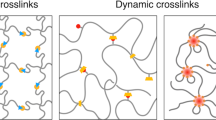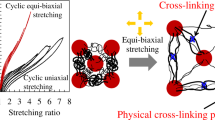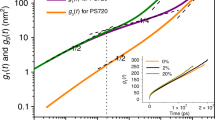Abstract
In this study, we examined the viscoelastic properties of a series of comb-shaped ring (RC) polystyrene samples with different branch chain lengths, i.e., the molecular weights of the ring backbone Mbb (≃ 4Me where Me is the entanglement molecular weight) and branch chains Mbr (≃ Me, 2Me, and 4Me). Even for the RC sample with the shortest branch chains, a plateau region was observed for the dynamic modulus G*(ω) in the middle angular frequency ω region, suggesting that intermolecular branch chain entanglement occurred. In the ω region between the plateau and terminal regions, G*(ω) was observed with a weaker ω dependence than the terminal relaxation. This behavior was more pronounced for RC samples with shorter branch chains and for the corresponding linear comb (LC) samples than for the RC ones. The molecular weight dependence of the zero-shear viscosity η0 and the steady-state recoverable compliance Jeo of the RC and LC samples was evaluated, and the effects of different backbone molecular structures (i.e., ring or linear) on the terminal relaxation behavior was discussed. Moreover, the G*(ω) data were analyzed with two models: the comb-Rouse model, in which the structures of the RC/LC molecules are taken into account by graph theory, and the Milner-McLeish model for entangled star-shaped polymers. The former model qualitatively described the terminal relaxation behavior of G*(ω) at low ω but failed to reproduce the plateau in the middle ω range. Conversely, the latter model described the entanglement plateau in the middle ω range, but the difference in the terminal relaxation regime for the RC/LC samples seen in the data and the comb-Rouse model disappeared.
This is a preview of subscription content, access via your institution
Access options
Subscribe to this journal
Receive 12 print issues and online access
$259.00 per year
only $21.58 per issue
Buy this article
- Purchase on Springer Link
- Instant access to full article PDF
Prices may be subject to local taxes which are calculated during checkout






Similar content being viewed by others
References
Ferry JD. Viscoelastic properties of polymers. New York: John Wiley and Sons; 1980.
Doi M, Edwards SF. The theory of polymer dynamics. Oxford: Clarendon; 1986.
Watanabe H. Viscoelasticity and dynamics of entangled polymers. Prog Polym Sci. 1999;24:1253–403.
McLeish TCB. Tube theory of entangled polymer dynamics. Adv Phys. 2002;51:1379–527.
Graessley WW. Polymeric liquids and network: dynamics and rheology. New York: Garland Science; 2004.
Roovers J. Melt properties of ring polystyrenes. Macromolecules. 1985;18:1359–61.
Kawaguchi D. Direct observation and mutual diffusion of cyclic polymers. Polym J. 2013;45:783–9.
Vlassopoulos D. Molecular topology and rheology: beyond the tube model. Rheol Acta. 2016;55:613–32.
Richter D, Goossen S, Wischnewski A. Celebrating Soft Matter’s 10th anniversary: topology matters: structure and dynamics or ring polymers. Soft Matter. 2015;11:8535–49.
Doi Y. Rheological properties of ring polymers and their derivatives. Nihon Reoroji Gakkaishi (J Soc Rheol Jpn). 2022;50:57–62.
Obukhov SP, Rubinstein M, Duke T. Dynamics of a ring polymer in a gel. Phys Rev Lett. 1994;73:1263–6.
Ge T, Panyukov S, Rubinstein M. Self-similar conformations and dynamics in entangled melts and solutions of nonconcatenated ring polymers. Macromolecules. 2016;49:708–22.
Doi Y, Takano A, Takahashi Y, Matsushita Y. Melt rheology of tadpole-shaped polystyrenes. Macromolecules. 2015;48:8667–74.
Doi Y, Takano A, Takahashi Y, Matsushita Y. Melt rheology of tadpole-shaped polystyrenes with different ring sizes. Soft Matter. 2020;16:8720–4.
Xia Y, Boydston AJ, Grubbs RH. Synthesis and direct imaging of ultrahigh molecular weight cyclic brush polymers. Angew Chem Int Ed. 2011;50:5882–5.
Schappacher M, Deffieux A. Atomic force microscopy imaging and dilute solution properties of cyclic and linear polystyrene combs. J Am Chem Soc. 2008;130:14684–9.
Doi Y, Iwasa Y, Watanabe K, Nakamura M, Takano A, Takahashi Y. Synthesis and characterization of comb-shaped ring polystyrenes. Macromolecules. 2016;49:3109–15.
Zhang S, Tezuka Y, Zhang Z, Li NA, Zhang W, Zhu L. Recent advances in the construction of cyclic grafted polymers and their potential applications. Polym Chem. 2018;9:677–86.
Roovers J, Graessley WW. Melt rheology of some model comb polystyrenes. Macromolecules. 1981;14:766–73.
Daniels DR, McLeish TCB, Crosby BJ, Young RN, Fernyhough CM. Molecular rheology of comb polymer melts. 1. linear viscoelastic response. Macromolecules. 2001;34:7025–33.
Kapnistos M, Vlassopoulos D, Roovers J, Leal LG. Linear rheology of architecturally complex macromolecules: comb polymers with linear backbones. Macromolecules. 2005;38:7852–62.
Inkson NJ, Graham RS, McLeish TCB, Groves DJ, Fernyhough CM. Viscoelasticity of monodisperse comb polymer melts. Macromolecules. 2006;39:4217–27.
Kirkwood KM, Leal LG, Vlassopoulos D, Driva P, Hadjichristidis N. Stress relaxation of comb polymers with short branches. Macromolecules. 2009;42:9592–608.
Iwawaki H, Inoue T, Nakamura Y. Rheo-optical study on bottlebrush-like polymacromonomer consisting of polystyrene. Macromolecules. 2011;44:5414–9.
Iwawaki H, Urakawa O, Inoue T, Nakamura Y. Rheo-optical study on dynamics of bottlebrush-like polymacromonomer consisting of polystyrene. II. Side chain length dependence on dynamical stiffness of main chain. Macromolecules. 2012;45:4801–8.
McLeish TCB. Hierarchical relaxation in tube models of branched polymers. Europhys Lett. 1988;6:511–6.
Milner ST, McLeish TCB. Parameter-free theory for stress relaxation in star polymer melts. Macromolecules. 1997;30:2159–66.
Rouse PE. A Theory of the linear viscoelastic properties of dilute solutions of coiling polymers. J Chem Phys. 1953;21:1272–80.
Ham JS. Viscoelastic theory of branched and cross-linked polymers. J Chem Phys. 1957;26:625–33.
Nitta K. A Graph-theoretical approach to statics and dynamics of treelike molecules. J Math Chem. 1999;25:133–43.
Nitta K. Graph-theoretical method for Rouse-Ham dynamics. Nihon Reoroji Gakkaishi (J Soc Rheol Jpn). 2002;30:49–54.
Zoller P, Walsh D. Standard pressure-volume-temperature data for polymers. Technomic Pub; Lancaster, 1995.
Doi Y, Takano A, Takahashi Y, Matsushita Y. Viscoelastic properties of dumbbell-shaped polystyrenes in bulk and solution. Macromolecules. 2020;54:1366–74.
Doi Y, Matsubara K, Ohta Y, Nakano T, Kawaguchi D, Takahashi Y, et al. Melt rheology of ring polystyrenes with ultrahigh purity. Macromolecules. 2015;48:3140–7.
Roovers J. Viscoelastic properties of polybutadiene rings. Macromolecules. 1988;21:1517–21.
McKenna GB, Hostetter BJ, Hadjichristidis N, Fetters LJ, Plazek DJ. A study of the linear viscoelastic properties of cyclic polystyrenes using creep and recovery measurements. Macromolecules. 1989;22:1834–52.
Plazek DJ, O’Rourke VM. Viscoelastic behavior of low molecular weight polystyrene. J Polym Sci Part A-2: Polym Phys. 1971;9:209–43.
Montfort JP, Marin G, Monge P. Effects of constraint release on the dynamics of entangled linear polymer melts. Macromolecules. 1984;17:1551–60.
Graessley WW, Roovers J. Melt rheology of four-arm and six-arm star polystyrenes. Macromolecules. 1979;12:959–65.
Fetters LJ, Kiss AD, Pearson DS, Quack GF, Vitus FJ. Rheological behavior of star-shaped polymers. Macromolecules. 1993;26:647–54.
Doi Y, Matsumoto A, Inoue T, Iwamoto T, Takano A, Matsushita Y, et al. Re-examination of terminal relaxation behavior of high-molecular-weight ring polystyrene melts. Rheol Acta. 2017;56:567–81.
Watanabe H, Inoue T, Matsumiya Y. Transient conformational change of bead-spring ring chain during creep process. Macromolecules. 2006;39:5419–26.
Tsolou GT, Stratikis N, Baig C, Stephanou PS, Marvantzas VG. Melt structure and dynamics of unentangled polyethylene riings: Rouse theory, atomistic molecular dynamics simulation, and comparison with the linear analogues. Macromolecules. 2010;43:10692–713.
Inoue T, Okamoto H, Osaki K. Birefringence of amorphous polymers. 1. Dynamic measurement on polystyrene. Macromolecules. 1991;24:5670–5.
Acknowledgements
The authors acknowledge Prof. H. Watanabe at Kyoto University for his valuable suggestions, especially for the Rouse analysis. The authors thank Dr. J. Roovers for his kind provision of rheological data for the star polystyrenes. This work was supported by JSPS Research Fellowships for Young Scientists (No. 14J03393 for YD) and Grant-in-Aids for Scientific Research (No. 21K14682 for YD and 24350056 for AT). This work was partly supported by the Collaborative Research Program of the Institute for Chemical Research, Kyoto University (Grant No. 2015-58), and AT is grateful for the support. This work was also supported by the Program for Leading Graduate Schools at Nagoya University entitled “Integrate Graduate Education and Research Program in Green Natural Sciences”.
Author information
Authors and Affiliations
Corresponding authors
Ethics declarations
Conflict of interest
The authors declare no competing interests.
Additional information
Publisher’s note Springer Nature remains neutral with regard to jurisdictional claims in published maps and institutional affiliations.
Supplementary information
Rights and permissions
Springer Nature or its licensor holds exclusive rights to this article under a publishing agreement with the author(s) or other rightsholder(s); author self-archiving of the accepted manuscript version of this article is solely governed by the terms of such publishing agreement and applicable law.
About this article
Cite this article
Doi, Y., Kitamura, J., Uneyama, T. et al. Viscoelastic properties of comb-shaped ring polystyrenes. Polym J 54, 1267–1277 (2022). https://doi.org/10.1038/s41428-022-00686-0
Received:
Revised:
Accepted:
Published:
Issue Date:
DOI: https://doi.org/10.1038/s41428-022-00686-0



